| Availability: | |
|---|---|
| Quantity: | |
Introduction:
The DTL-1 is a specialized bimetallic terminal lug, a critical component in electrical systems for creating a reliable and safe connection between copper and aluminum conductors.
The DTL-1 cable lugs is not just a simple connector; it is a precision-engineered solution that ensures the long-term safety, reliability, and efficiency of electrical connections in mixed-metal environments.
Material:Al≥99.5%,CU≥99.9%
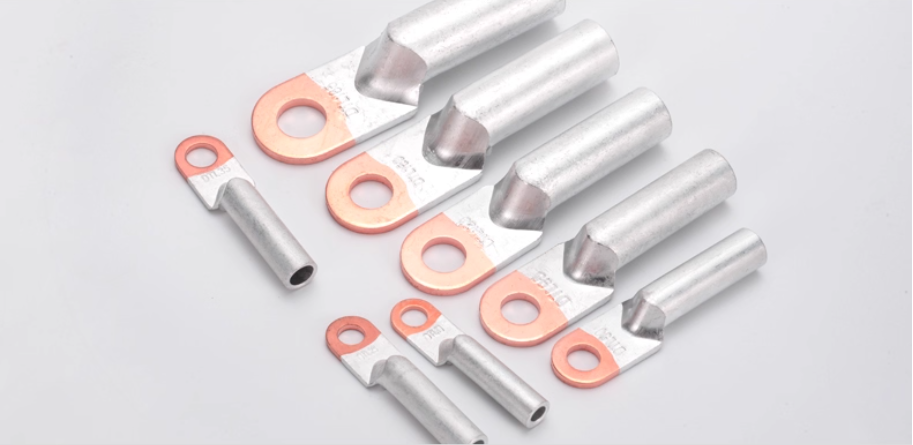
Drawings:
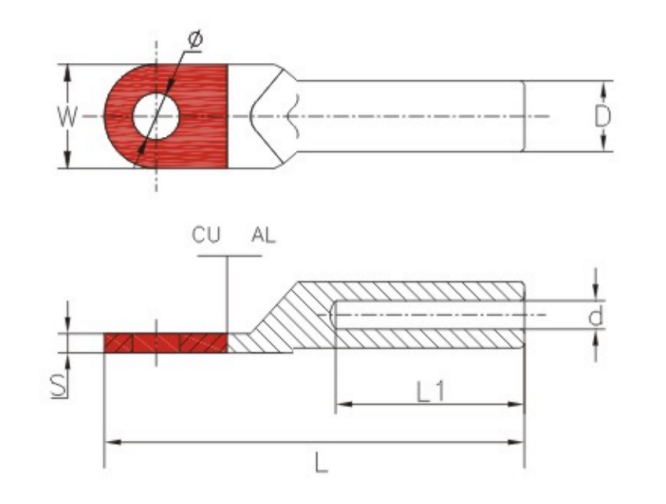
Specifications:
Type | φ±0.3 | D±0.2 | d±0.2 | L±2 | L1±2 | W±0.2 | S±0.2 |
DTL-1-10 | 10.5 | 9.2 | 5.2 | 66.2 | 30 | 16 | 2.2 |
DTL-1-16 | 10.5 | 10.6 | 6.2 | 66.2 | 30.4 | 16 | 2.2 |
DTL-1-25 | 10.5 | 12.4 | 8 | 74 | 35 | 17.5 | 2.6 |
DTL-1-35 | 10.5 | 13.6 | 8 | 80 | 37 | 20 | 3 |
DTL-1-50 | 13 | 16 | 10 | 90.2 | 44 | 23 | 3.4 |
DTL-1-70 | 13 | 18 | 12 | 98.4 | 45 | 27 | 3.8 |
DTL-1-95 | 13 | 21 | 13.8 | 106.4 | 49.4 | 28 | 4 |
DTL-1-120 | 13 | 22.4 | 14.8 | 114 | 53.8 | 30 | 4.8 |
DTL-1-150 | 13 | 25 | 17 | 126 | 56 | 34 | 5 |
DTL-1-185 | 13 | 27 | 19 | 133.2 | 59.6 | 37 | 5.6 |
DTL-1-240 | 13 | 29.2 | 20.8 | 140 | 63 | 40 | 6 |
DTL-1-300 | 13 | 33.2 | 23.2 | 162 | 69 | 50 | 7 |
DTL-1-400 | 17 | 38.4 | 26.8 | 166 | 76 | 50 | 7.1 |
DTL-1-500 | 17 | 40.4 | 28.8 | 185 | 75 | 54.8 | 7.9 |
DTL-1-630 | 17 | 54.6 | 33 | 201 | 81 | 59.6 | 9 |
Primary Function and Design:
Copper aluminium cable lugs’ core purpose is to serve as a transition point, effectively joining a copper cable to an aluminum busbar, cable, or terminal point (or vice-versa). The terminal is expertly manufactured with two distinct metal sections bonded together:
Copper Section (Reddish-Brown): This terminal connector is designed to be connected to a copper conductor. It typically features a cylindrical barrel that is crimped onto the copper wire.
Aluminum Section (Silver): This end is designed for connection to aluminum. It is formed into a flat, eyelet or lug shape with a hole, allowing it to be securely bolted to a terminal, such as on a circuit breaker, transformer, or grounding busbar.
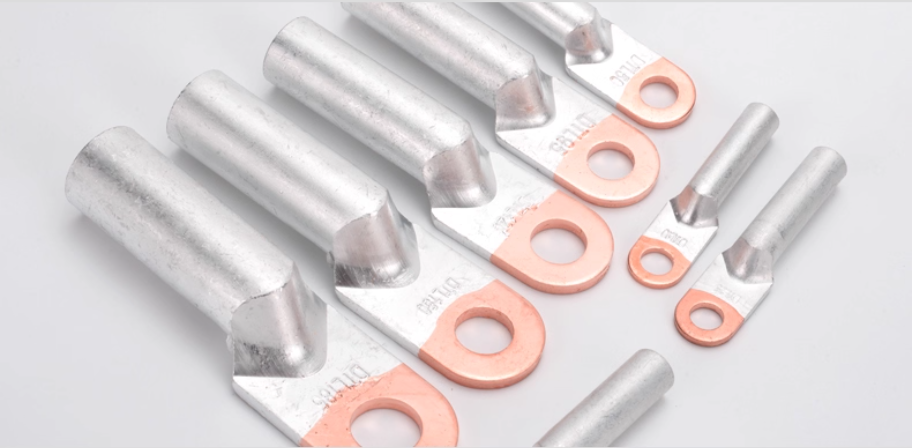
Key Technical Advantages:
Prevention of Galvanic Corrosion: This is the most important feature. When copper and aluminum are directly connected in the presence of an electrolyte (like moisture), they form a galvanic cell, leading to rapid oxidation, increased resistance, overheating, and ultimately connection failure. The DTL-1's bimetallic interface is engineered (often through a friction-welding or diffusion-bonding process) to create a permanent, low-resistance bond that isolates the two metals from direct electrochemical contact, thereby preventing this corrosive reaction.
Reliable Performance: By providing a dedicated and optimized connection for each metal type, it ensures a stable, low-resistance electrical path, minimizing voltage drop and power loss.
Mechanical Strength: The solid construction provides excellent mechanical strength, making the connection resistant to vibration and physical stress.
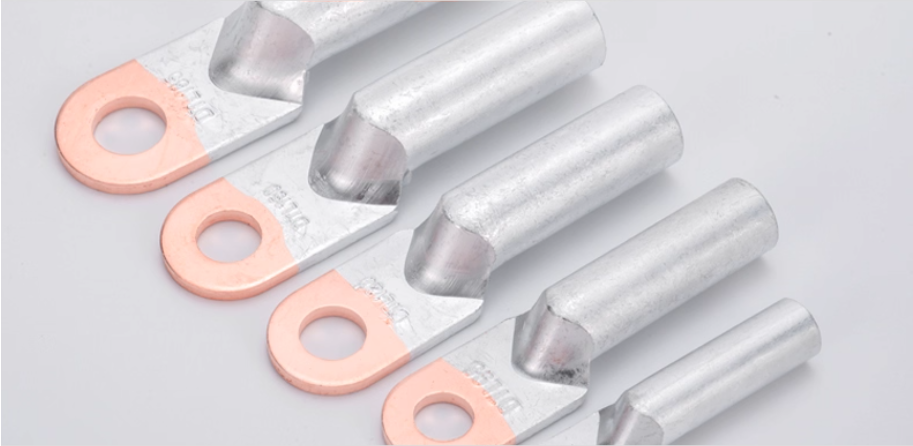
Common Applications:
DTL-1 bimetallic cable lugs are essential in various electrical installations where a transition between copper and aluminum wiring is necessary, such as:
Power Distribution Systems: Connecting aluminum utility cables to copper wiring within buildings or switchgear.
Transformer Connections: Linking aluminum transformer windings to copper busbars or cables.
Grounding Systems: Creating a connection between copper grounding electrodes and aluminum grounding conductors.
Renewable Energy Systems: Used in solar and wind farms where different conductor materials meet.
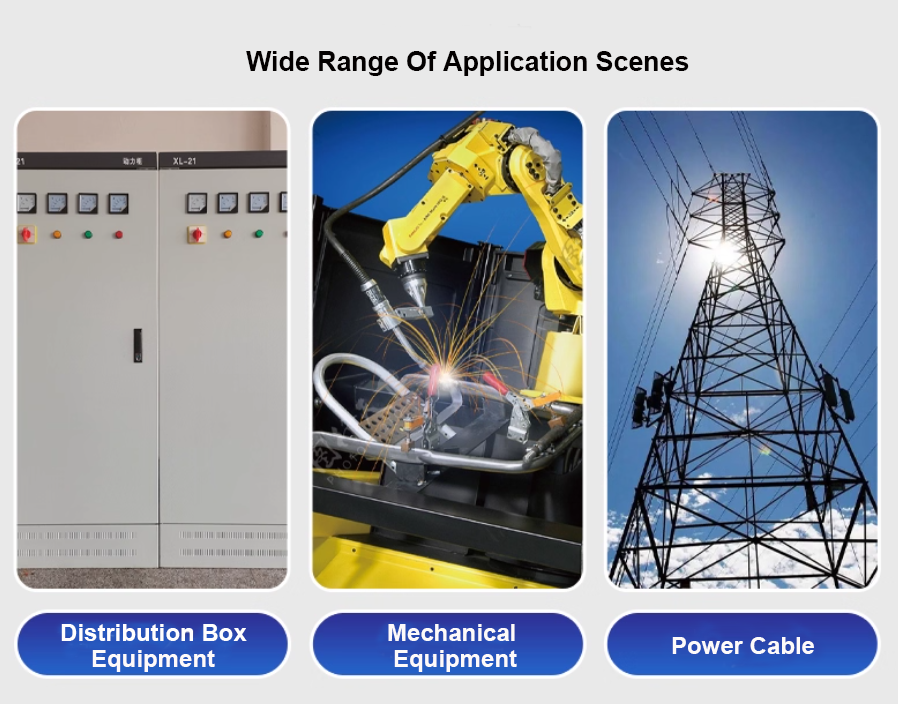

Introduction:
The DTL-1 is a specialized bimetallic terminal lug, a critical component in electrical systems for creating a reliable and safe connection between copper and aluminum conductors.
The DTL-1 cable lugs is not just a simple connector; it is a precision-engineered solution that ensures the long-term safety, reliability, and efficiency of electrical connections in mixed-metal environments.
Material:Al≥99.5%,CU≥99.9%

Drawings:

Specifications:
Type | φ±0.3 | D±0.2 | d±0.2 | L±2 | L1±2 | W±0.2 | S±0.2 |
DTL-1-10 | 10.5 | 9.2 | 5.2 | 66.2 | 30 | 16 | 2.2 |
DTL-1-16 | 10.5 | 10.6 | 6.2 | 66.2 | 30.4 | 16 | 2.2 |
DTL-1-25 | 10.5 | 12.4 | 8 | 74 | 35 | 17.5 | 2.6 |
DTL-1-35 | 10.5 | 13.6 | 8 | 80 | 37 | 20 | 3 |
DTL-1-50 | 13 | 16 | 10 | 90.2 | 44 | 23 | 3.4 |
DTL-1-70 | 13 | 18 | 12 | 98.4 | 45 | 27 | 3.8 |
DTL-1-95 | 13 | 21 | 13.8 | 106.4 | 49.4 | 28 | 4 |
DTL-1-120 | 13 | 22.4 | 14.8 | 114 | 53.8 | 30 | 4.8 |
DTL-1-150 | 13 | 25 | 17 | 126 | 56 | 34 | 5 |
DTL-1-185 | 13 | 27 | 19 | 133.2 | 59.6 | 37 | 5.6 |
DTL-1-240 | 13 | 29.2 | 20.8 | 140 | 63 | 40 | 6 |
DTL-1-300 | 13 | 33.2 | 23.2 | 162 | 69 | 50 | 7 |
DTL-1-400 | 17 | 38.4 | 26.8 | 166 | 76 | 50 | 7.1 |
DTL-1-500 | 17 | 40.4 | 28.8 | 185 | 75 | 54.8 | 7.9 |
DTL-1-630 | 17 | 54.6 | 33 | 201 | 81 | 59.6 | 9 |
Primary Function and Design:
Copper aluminium cable lugs’ core purpose is to serve as a transition point, effectively joining a copper cable to an aluminum busbar, cable, or terminal point (or vice-versa). The terminal is expertly manufactured with two distinct metal sections bonded together:
Copper Section (Reddish-Brown): This terminal connector is designed to be connected to a copper conductor. It typically features a cylindrical barrel that is crimped onto the copper wire.
Aluminum Section (Silver): This end is designed for connection to aluminum. It is formed into a flat, eyelet or lug shape with a hole, allowing it to be securely bolted to a terminal, such as on a circuit breaker, transformer, or grounding busbar.

Key Technical Advantages:
Prevention of Galvanic Corrosion: This is the most important feature. When copper and aluminum are directly connected in the presence of an electrolyte (like moisture), they form a galvanic cell, leading to rapid oxidation, increased resistance, overheating, and ultimately connection failure. The DTL-1's bimetallic interface is engineered (often through a friction-welding or diffusion-bonding process) to create a permanent, low-resistance bond that isolates the two metals from direct electrochemical contact, thereby preventing this corrosive reaction.
Reliable Performance: By providing a dedicated and optimized connection for each metal type, it ensures a stable, low-resistance electrical path, minimizing voltage drop and power loss.
Mechanical Strength: The solid construction provides excellent mechanical strength, making the connection resistant to vibration and physical stress.

Common Applications:
DTL-1 bimetallic cable lugs are essential in various electrical installations where a transition between copper and aluminum wiring is necessary, such as:
Power Distribution Systems: Connecting aluminum utility cables to copper wiring within buildings or switchgear.
Transformer Connections: Linking aluminum transformer windings to copper busbars or cables.
Grounding Systems: Creating a connection between copper grounding electrodes and aluminum grounding conductors.
Renewable Energy Systems: Used in solar and wind farms where different conductor materials meet.

